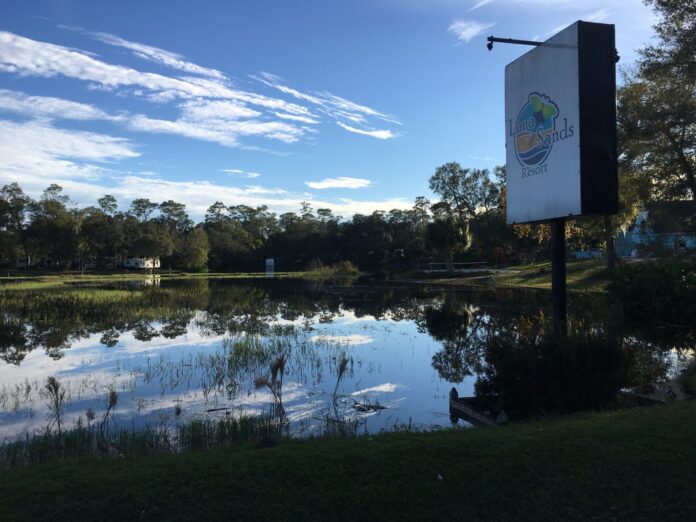
WATER, WATER, EVERYWHERE — Floodwaters remain high in much of West Volusia. Water in this lake along East Minnesota Avenue in Orange City appears to threaten the roadway in some areas.
Three months after Hurricane Ian dumped nearly a foot-and-a-half of rain on West Volusia, and about a month-and-a-half after Hurricane Nicole added to the total, high water in some low-lying and poorly drained locales has been slow to recede.
“I have 15 inches of water,” Annette Duke, who lives on Stone Island, told the County Council. “I had no idea this was coming.”
Stone Island, on the north shore of Lake Monroe and the St. Johns River, is one of the areas vulnerable to flooding during periods of extra rains.
Duke blamed Deltona for compounding her problems by opening a drainage system that moves water from the northern part of the city through ditches and canals into Lake Bethel and into the St. Johns River.
A wet rainy season left the soil in many places saturated. The rain from Ian, dubbed a 500-year storm, wrought flooding of streets, roads and homes in places that had not known such problems before.
In some places, sandbags were of little help. Parts of Deltona seemed to resemble Venice, as some people could not get to or away from their homes except by boats or kayaks or high-mounted trucks.
When will the waters abate? It’s difficult to say, according to Volusia County Groundwater Program Manager Tom Carey.

THE WATER MAN — Volusia County Groundwater Program Manager Tom Carey takes part in an episode of the county’s Volusia Today program, published on YouTube.
“There’s a lot of factors,” Carey said, when asked how soon the drying may occur.
Those factors include temperatures, humidity, topography, and the amounts and levels of saturation in the ground already, among other things. Another factor may be the additional rainfall, if any.
Thus far in the 2022 calendar year, West Volusia has received some 66 inches of precipitation, Carey noted.
“The year’s not over. We’ve still got December,” he said.
The normal annual rainfall in the western half of the county is 55 inches, but Hurricane Ian pushed us well over that figure with 17.91 inches during its Sept. 28-29 visit. Hurricane Nicole added 3.82 inches on Nov. 9 and another 0.23 of an inch on Nov. 10. For the calendar year thus far, the DeLand area has a total of 62 inches of rain.
Does rapid and rampant development contribute to the stormwater woes now coming
to the fore — or is it simply getting more attention?
“Different people have their opinions on it. Stormwater, in my opinion, is not more of a problem with development, because each development has to have appropriate retention, including stormwater ponds,” Carey told The Beacon. “Say you get a quarter of an inch of rain, and if that were to fall on a 10-acre field, probably none of that would make it down to the aquifer, because it’s just not enough to push down past the root zone and into the aquifer. You get that same quarter of an inch of rain on a 10-acre subdivision with retention ponds, you’re still going to have rainwater hitting the lawns and yards and getting into the soil, but you’re also going to have that runoff stacking up in a retentive pond, maybe a foot or so, and that’s more head pressure to push water down into the aquifer.”
“Development with appropriate retention and stormwater design can actually increase recharge to the aquifer,” he concluded.
Carey pointed out, however, that prolonged heavy rains such as the ones associated with Hurricane Ian are simply too much for virtually any stormwater system.
Thus, the large amounts of water will likely produce “lateral flows” that will drive water in varying directions in search of lower levels and thus slowing drainage.
One who believes the spread of homes, businesses and roadways is affecting flooding is Richard Feller, a member of Volusia County’s Planning and Land Development Regulation Commission.

“I think what we’re seeing is the new developments are having an impact. I’m worried about exacerbating that impact,” he said, as the PLDRC discussed a proposal for multifamily housing along State Road 472 near Orange City.
Feller noted there was still water on many properties along East Minnesota Avenue, several days after Hurricane Nicole and more than a month-and-a-half after Hurricane Ian brought its drenching rains.
Meanwhile, Deltona’s new mayor says he wants to work on ways to head off flooding caused by future adverse weather events. Troubled by the high waters in some neighborhoods, Mayor Santiago Avila Jr. says he would like to secure state funding for drainage and protection against flooding. He said he would like to talk with District 5 Volusia County Council Member-elect and former state Rep. David Santiago regarding state funding possibilities.
Avila also has an ambitious plan for keeping Elkcam Boulevard — an east-west arterial road — open despite heavy rains.
“I’m also asking for two bridges on Elkcam,” he said, referring to a pair of low-lying areas prone to flooding because of lake waters lapping close to the pavement.
Elkcam was closed for several days following Hurricane Ian, as two portions of DuPont Lake united by crossing the road. A similar situation exists a short distance eastward.
“We could have bridges that could boost ecotourism by allowing kayaks and boats to go under them and get to other lakes,” Avila said.
Building such bridges and making lake-related improvements along the road may require approval from and coordination with the U.S. Army Corps of Engineers, he acknowledged.